Ted Joans
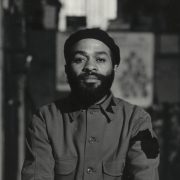

Search for art, find what you are looking for in the museum and much more.
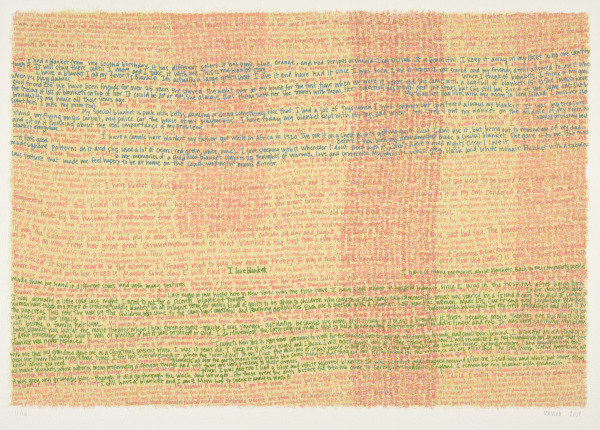
Words Matter underscores the diversity of contemporary Native experience, highlighting artists who combine text and image to chronicle tragedies of history, but also to supply messages of hope, humor, survival and prosperity. Untold History showcases Indigenous comic book and graphic novel artists and writers who meld contemporary culture with their rich heritage and identity.
Welcome to an online presentation of the exhibition Words Matter which was on view at VMFA from July 30, 2022 – January 20, 2023. More information about the exhibition can be found on the exhibition page.
Words Matter underscores the richness and diversity of the contemporary Native experience, highlighting nine artists who have combined text and image. Native lives, regardless of tribal designation, are intrinsically linked by a common oppression of their culture by outsiders, facilitated through the use of the written word, which was, and continues to be, a powerful weapon used against Native people. These works provide a means for chronicling the tragedies of history, and to supply messages of hope, humor, survival and prosperity.
Shan Goshorn and Diego Romero reference, both directly and indirectly, some of the most destructive documents written by colonizers: the Doctrine of Discovery and the Indian Removal Act. Melanie Yazzie juxtaposes Navajo, ancient hieroglyphics, and English as a reminder that there are languages far older than those spoken by Europeans in North America. Marie Watt uses words as a design element, weaving stories together both literally and figuratively. Robert Houle and Larry McNeil appropriate older literary and pop culture writings while providing humor and astute cultural commentary. Lynne Allen, Rick Bartow, and Demian DinéYazhi likewise borrow from pop culture to amplify a reimagining of Indigenous history and culture.
This page also features the companion exhibit Untold History, a collection of Indigenous comic book and graphic novel artists that was on view in VMFA’s Margaret R. and Robert M. Freeman Library.
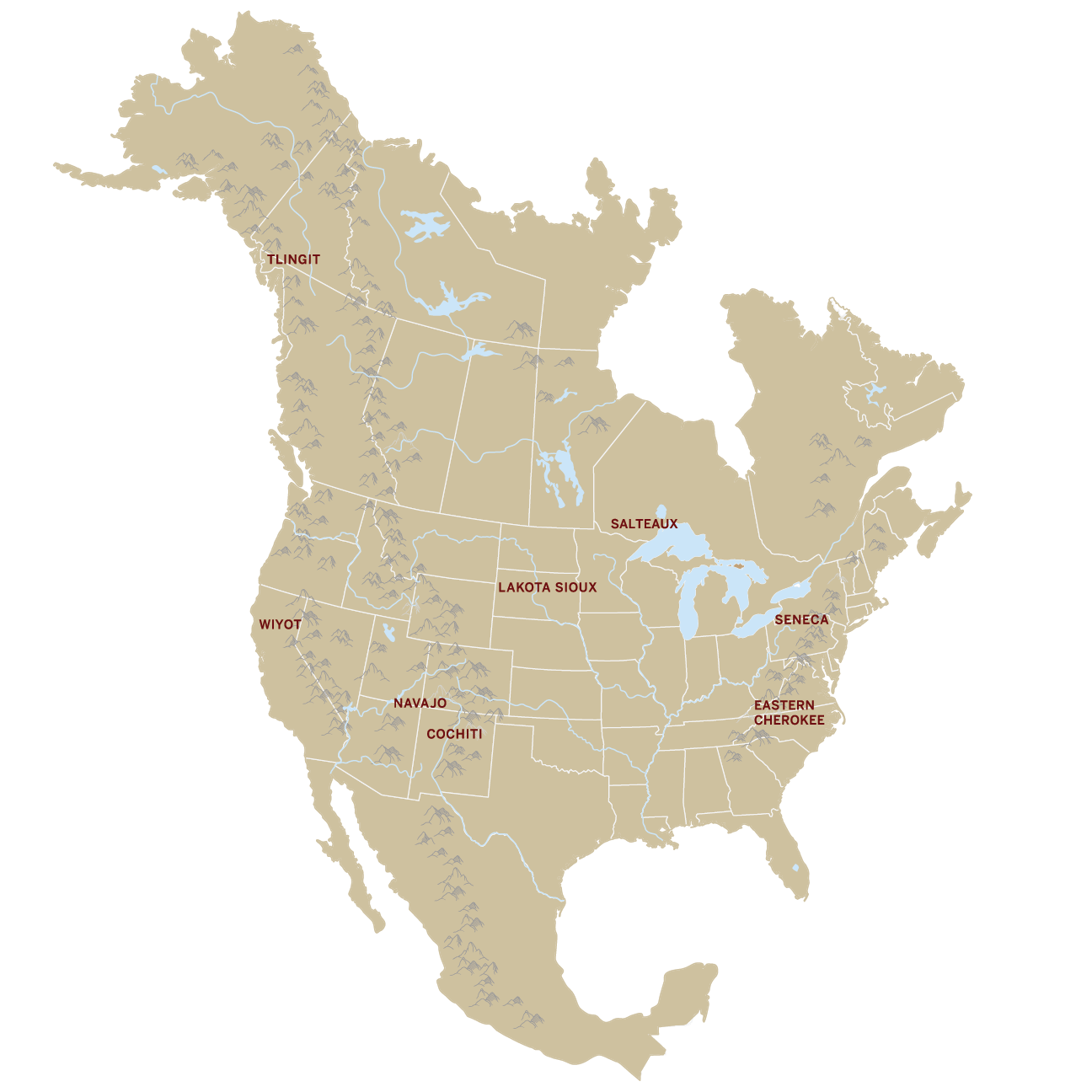
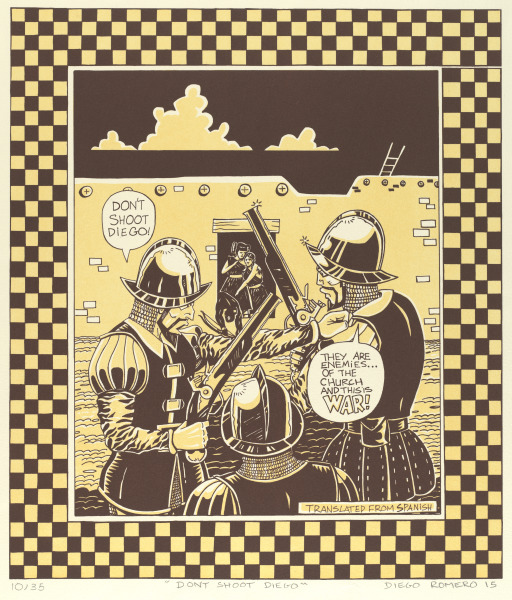 Don’t Shoot, Diego!, 2015, Diego Romero (Cochiti, 1964-), three color lithograph. On loan from the Edward J. Guarino collection
Don’t Shoot, Diego!, 2015, Diego Romero (Cochiti, 1964-), three color lithograph. On loan from the Edward J. Guarino collection Diego Romero imagines, in comic-book format, conversations among Spanish conquistadors as they carried out their faith-driven initiative. Two women hover in fear over the body of a Pueblo man sprawled across the doorway of his family’s home. The soldier on the left attempts to prevent more bloodshed by the soldier named Diego, his rifle still smoking while he states his firm belief that they are in a war for not just the lands they have invaded, but for the souls of its inhabitants as well.
The Inter Caetera, or Doctrine of Discovery, issued by Pope Alexander VI in 1493, became the basis for European claims to Indigenous lands in the New World. According to the edict, any land not inhabited by Christians was there to be ‘discovered and claimed,’ its people forced to convert to Christianity or face fatal consequences. The desired outcome, as written by the pope was “…that the Christian religion be {…} everywhere increased and spread, that the health of souls be cared for and that barbarous nations be overthrown and brought to the faith itself.”
To read the full text of this document visit The Doctrine of Discovery (1493). Did you know that in 2005 Ruth Bader Ginsburg cited the Doctrine of Discovery in the decision about City of Sherrill v. Oneida Indian Nation of N.Y.?
Learn more about Jamestown and Beyond: the World of 1607.
One of the earliest Indigenous cultures that occupied the Puebloan Southwest, the Mimbres culture (AD 1000-1150), lived in Southern New Mexico and created a unique black-on-white decorative style that Romero draws stylistic inspiration from. The simplified, blocky figures and bold pictorial outlines seen in Romero’s work were common design elements for Mimbres potters.
This photograph is part of Cara Romero’s Evolvers series, in which she brings visibility to cultures and histories that informed and continue to inform the American landscape.Romero is an enrolled citizen of the Chemehuevi tribe of California and is the wife of Diego Romero.
This print titled “King of the Monsters,” is by Mateo Romero and featured in the companion exhibition Untold History. Romero, like his brother Diego, utilizes text within his image to enhance the story.
Demian DinéYazhi’s There’s No Place Like Hózhó illustrates the belief in a person’s connection to a place and the well-being that results. The artist has positioned a textual reference—Hozho—in the center of the composition and surrounds it with visual references to the Navajo traditional home: the six-sided log hogan. Combined, these represent the true spirit of Hozho, which is a complex philosophy and belief system that guides one’s actions and places emphasis on harmony, peace, and both physical and spiritual health.
“There’s no place like home. There’s no place like home.” In the 1939 film The Wizard of Oz, Dorothy’s iconic mantra condenses the meaning of what home is for each of us: a place we associate with familiarity, love, a safe place, a place of origin.
By the 19th century, the United States was a young but powerful country and owed a great deal of its wealth and power to the claiming of land and resources that belonged to Native Americans. Much of Abraham Lincoln’s success in his campaign for the presidency came from support from land-poor settlers, called “free-soilers,” who vocalized their desire that the government open up indigenous lands west of the Mississippi River. So, in the midst of the Civil War, Lincoln persuaded Congress to pass the Homestead Act and the Pacific Railroad Act, both in 1862. Combined, these acts broke multiple treaties with indigenous nations and transferred approximately 500 million acres of tribal lands into the hands of railroad companies, land speculators, and white squatters.
In 1887, Senator Henry Dawes wrote the General Allotment Act (also known as the Dawes Act), which imposed individual land ownership onto Indigenous people. On the surface, this policy was presented as a way to assimilate Native people into the dominant culture and make it easier for them to adjust to the new life that such an “opportunity” presented. But there was a more sinister motive: the ability to break apart large land trusts and make more parcels available for whites to purchase. All told, the allotment reduced the overall indigenous lands by half. Thus, a quieter, more powerful weapon than firearms was put into use: the printed word. From the federal government all the way down to local municipalities, newspapers were increasingly contracted to print proclamations of legal intent. An 1869 broadside advertises “Lands for the Landless! Homes for the Homeless!!” In just eight words, this proclamation was able to prompt those with an entrepreneurial spirit while simultaneously confirming to the Native occupants that they had no legal claim to that land.

Lucy Ganje combines her knowledge of the printing process with her investigation into the history of images such as broadsides to relay a provocative message about the power of art and design as a social and political tool. In her collaboration with Daniel Heyman on “In Our Own Words,” Ganje has produced large-scale broadsides nearly identical in format to the 19th century proclamations of intent. Ganje’s broadsides, however, are made up of excerpts from the interviews that she and Heyman conducted with members of the The Mandan, Hidatsa, & Arikara Nation (Three Affiliated Tribes); the Spirit Lake Nation; the Standing Rock Sioux Tribe; and the Turtle Mountain Band of Chippewa Indians. They are intimate, poignant, and heart-breaking while simultaneously hopeful and powerful. In “My Parents Had No Parenting,” the reader’s eyes are drawn to phrases such as “unresolved grief,” “soul wound,” and “boarding school legacy.” And yet, the largest statement expressed in this print is “be proud.” It is through this medium that Ganje is able to assist in giving Native people back their voices. Words have been used for centuries to diminish the position of indigenous people and here they are serving to empower.
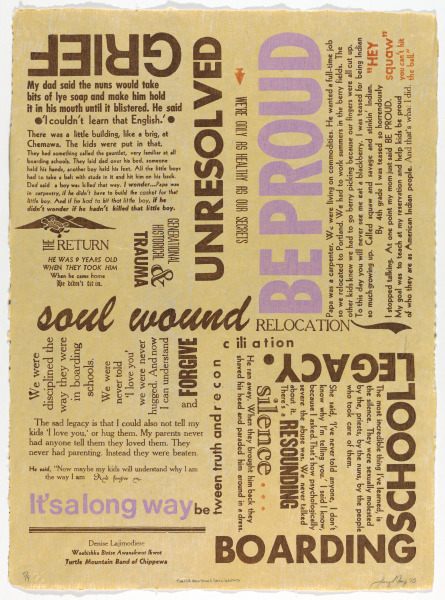 My Parents Had No Parenting, 2015, Lucy Ganje (American, 1949-), Letterpress on handmade mulberry and North Dakota milkweed paper. Virginia Museum of Fine Arts, Arthur and Margaret Glasgow Endowment, 2017.119.8b.
My Parents Had No Parenting, 2015, Lucy Ganje (American, 1949-), Letterpress on handmade mulberry and North Dakota milkweed paper. Virginia Museum of Fine Arts, Arthur and Margaret Glasgow Endowment, 2017.119.8b. Native peoples, particularly in the plains and southwest, were often conflated in the minds of Europeans who had not visited America. They relied instead on written descriptions and carefully manipulated images which bordered on the fantastic. Robert Houle references two popular 19th century misrepresentations in his print Medicine Lodge: a German-published postcard from the early 20th century and German author Karl May’s (1842-1912) fictional travel-adventure series Winnetou. Though May never set foot in America, his novels provided elaborate written descriptions of life among the Mescalero Apache people, with himself as protagonist and ‘reliable’ narrative voice. Both sources utilized many of the same popular tropes as James Fenimore Cooper (1811-1851) in his Leatherstocking Tales (1823-1841),the most famous of which was The Last of the Mohicans. Houle writes that he selected this fictionalized postcard image because it evokes “the description of May’s hero {…} the archetypal noble savage, Winnetou, who is not a historical Apache but is instead […] a symbol of natural human experience destroyed by civilization.”
German author Karl Friedrich May, who published the best-selling novels about the Apache warrior Winnetou and his German-American blood brother Old Shatterhand in 1893, had no direct knowledge of Native American culture. The popularity of his imaginative works—along with the numerous movies, plays, and popular festivals they inspired, advanced many of the pervasive and misleading stereotypes that still exist about Native American people and their cultures.
Explore Decolonization Through the Art of Robert Houle: Make a Creative Response to a Treaty Text, an Independent Student Learning Activity for grades 7–12.
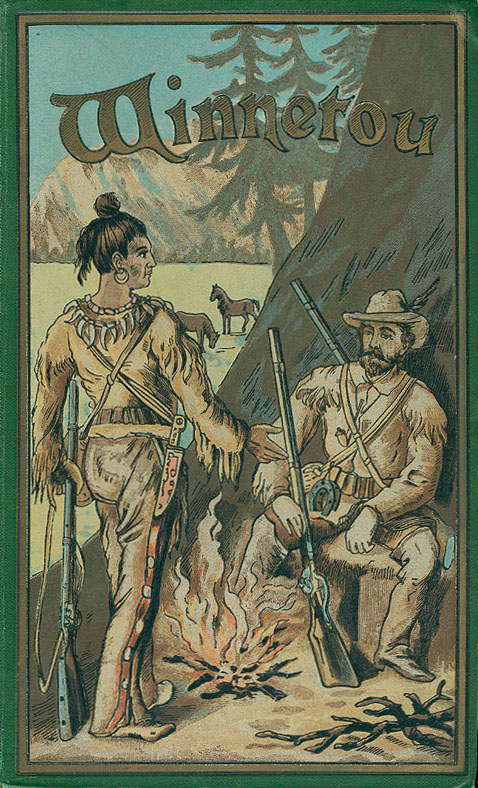 By Verlag Friedrich Ernst Fehsenfeld - Karl-May-Wiki, Public Domain, https://commons.wikimedia.org/w/index.php?curid=13923148
By Verlag Friedrich Ernst Fehsenfeld - Karl-May-Wiki, Public Domain, https://commons.wikimedia.org/w/index.php?curid=13923148 “Lone Ranger: Now I remember you! You’re Tonto!
Tonto: Ugh. Me call you Kemo Sabay.”
– Lone Ranger comic series, 1940s
Larry McNeil has held a long fascination with American mythological stories, particularly those that presented cowboys as rebellious individualists who “wrestled the frontier into submission.” The heroic cowboy trope appealed to the nation’s self-styled captains of industry, who saw themselves as pioneers of sorts, but according to McNeil “this mythological story was flawed from the beginning.”
One of the most famous of the cowboy-heroes was the Lone Ranger, first brought to life in a 1933 radio broadcast. He and his Native American side-kick, Tonto, would later become film, television and comic book icons. In Native Epistemology, McNeil transforms Tonto from the Lone Ranger’s less-educated but loyal companion into an indigenous intellectual, using sarcasm and humor to point out just how little the hero, and by extension all those who admired him, actually understood.
“Native Epistemology” is one work in Larry McNeil’s series titled Tonto and Lone Ranger Escapades. Explore Larry McNeil’s Tonto and Lone Ranger Escapades series on his website.
Writing systems among early Indigenous peoples was uncommon, but not altogether absent. A winter count is a timekeeping system written in a circular pictograph. Rather than keeping a chronological calendar, it references significant events and experiences that add to the historical document of a community. In Lynne Allen’s work, the writing in red represents her own winter count, while the writing in gray is taken from her grandmother’s written manuscript. Embedded in the left figure are Sioux pictographs found in her great-grandmother Ita ta win’s journals; a woman who lived through both forced relocation and boarding schools. Within the right figure, cowboys chase Indians between stripes that recall an old television and part of the culture in which she herself grew up. Allen also includes a quote from Eleanor Torrey West, an admired environmentalist.
Learn more about Torrey West on the Ossabaw Island Foundation website.
Explore the National Museum of the American Indian’s resource Lone Dog’s Winter Count: Keeping History Alive.
Listen to contemporary Native American artist Molly Murphy Adams discuss the importance of moccasins to Indigenous people.
Written words are often given primacy over spoken ones. By extension, it is generally the case that written history is considered absolute, while oral histories are considered subject to an individual’s imprecise memory. However, for most Indigenous people prior to European arrival, storytelling was the way in which history endured through time.
Marie Watt believes that art and language have the capacity to transport and carry the voices that are missing from American history and are still active today. In her Blanket Series, she combines the significance of blankets to her family with a type of stream of conscience practice from communal sewing sessions. Her print from this series, Continuum (Book 1) is a weaving together of words to create the appearance of this important symbol of community. Watt says that, “Blankets are markers for memories and stories, they can also be memorials…they are enduring records of people’s lives.”
Written words are often given primacy over spoken ones. By extension, it is generally the case that written history is considered absolute, while oral histories are considered subject to an individual’s imprecise memory. However, for most Indigenous people prior to European arrival, storytelling was the way in which history endured through time.
Watch the Meet the Artist: Marie Watt video, created by the Smithsonian American Art Museum.
Listen to fiber artist DY Begay discuss her practice in this Artist Profile video.
Melanie Yazzie makes use of a collage effect in Some of Us Say, scattering English phrases (culture blending) with their Navajo equivalent (bilagaána) across the page. These words remind the viewer that European languages are not the earliest ones spoken in North America, nor do they always accurately encapsulate such important Indigenous concepts as belonging and tradition. The connection to place is further exemplified by the filling of two abstracted figures with the artist’s fingerprints, in essence stamping her presence and making it known.
Explore a map of indigenous languages at Native Land Digital.
While early European explorers chronicled in detail the people, plants, and animals they encountered in the New World, their discoveries were rarely considered in holistic terms. In History Speaking, Melanie Yazzie combines layers of English text with scientific or documentary-style drawings of flora and fauna. A series of symbols are included along the right side of the print. Yazzie describes these as “prayers of gratitude and also prayers for future crops.” The entirety of the work is about the importance of corn to Indigenous people and pays homage to both the practice of food planting, as well as the delicate balance of the ecosystem.
Learn more about 7 Foods Developed by Native Americans.
Many of Rick Bartow’s works reference the theme of transformation and the power of storytelling. He was an avid reader, writer, musician and storyteller who described his artistic process giving him the ability to vent something of his Native experience in an articulate manner. Crow in a Boat is a charming illustration of a common character in Native stories, here seen with text that is reminiscent of an early childhood poem or storybook.
Native children had a unique vantage point from which to experience the ‘reading revolution’ of the 19th century. Reading transitioned from an intensive practice of memorizing religious texts to a rapid consumption of information and entertainment. For school children, this meant recitation of poetry and prose and schoolbooks frequently romanticized the world of the American pioneer. As Native children were conscripted to boarding schools, they were often on the front lines of these new approaches to pedagogy and didactics, while simultaneously being forbidden to speak in their native language or relate their own stories.
Shan Goshorn’s Shrouded in Grey is a single-weave basket using Arches paper instead of the traditional white oak or river cane. Printed on the paper strips are excerpts from Raphael Lemkin’s definition of genocide along with three documents: The Indian Removal Act (1830), The Medicine Lodge Treaty (1867), and the names of children on the Carlisle Indian Boarding School student roster (1879-1918). By reading these words and names, the viewer is confronted with the reality of genocide and loss; not only loss of life, but also of one’s land and culture.
Once the Doctrine of Discovery established a justification of the seizure of Native land, it would become the foundation for the Indian policies set forth by the U.S. Government from 1783-1830. The prevailing sentiment of white settlers of the time was expressed by President Andrew Jackson: “And is it supposed that the wandering savage has a stronger attachment to his home than the settled, civilized Christian?” Jackson’s Indian Removal Act of 1830 set in motion the dislocation of tens of thousands of Natives from their ancestral homelands in the Southeast.
Untold history is illustrated as Jason Garcia positions primary actors in the Pueblo Revolt of 1680 as superheroes seeking truth and justice. Arigon Starr offers compelling stories of Navajo Code Talkers delivering classified information during World War II. Starr also reimagines the classic superhero narrative, centering a Native American as the protagonist in Super Indian. Jeffrey Veregge bridges pop culture and cultural design elements, weaving Salish formline designs into his revival of Marvel’s first Native American superhero, Red Wolf, completely transforming the character from the original 1970s version. Ceramic artist Les Namingha decorates a traditional Hopi jar with the Pokemon Deoxys and Surskit.
Read the essay titled Indigenous Representation in Comics and Graphic Novels by Michael A. Sheyahshe (Caddo).
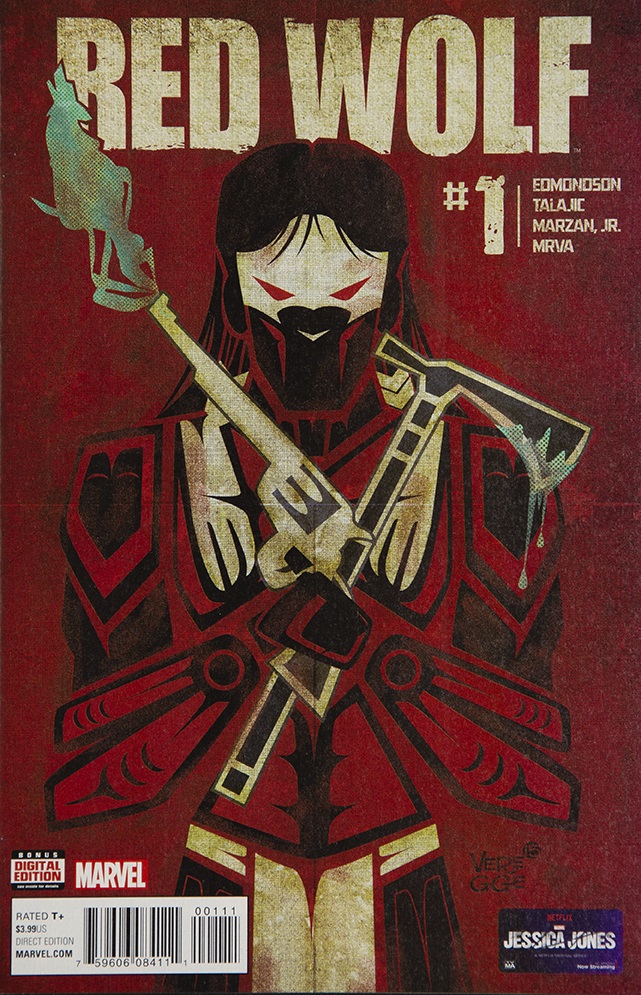 Red Wolf, 2015-2016, vol. 1, Marvel Comics, Jeffrey Veregge (Port Gamble S'Klallam, b. 1974), Virginia Museum of Fine Arts, Margaret R. and Robert M. Freeman Library and Special Collections
Red Wolf, 2015-2016, vol. 1, Marvel Comics, Jeffrey Veregge (Port Gamble S'Klallam, b. 1974), Virginia Museum of Fine Arts, Margaret R. and Robert M. Freeman Library and Special Collections Jeffrey Veregge is from the Port Gamble S’Klallam Tribe in Washington state. Many of his fans have dubbed his unique style “Salish Geek” because of its combination of traditional Northwest Coast form-line design and pop culture iconography and subject matter. Veregge has won critical acclaim for his work in both large-scale installations and book size formats. He has created over 100 comic book covers for Marvel, IDW, Valiant, Dynamite, Boom! & Darkhorse Comics.
Learn more about Jeffrey Veregge and see some of his other work on his website.
Jeffrey Veregge’s large-scale installation “Of Gods and Heroes”, is currently on view at the National Museum of the American Indian in New York City. Visit their website to learn more.
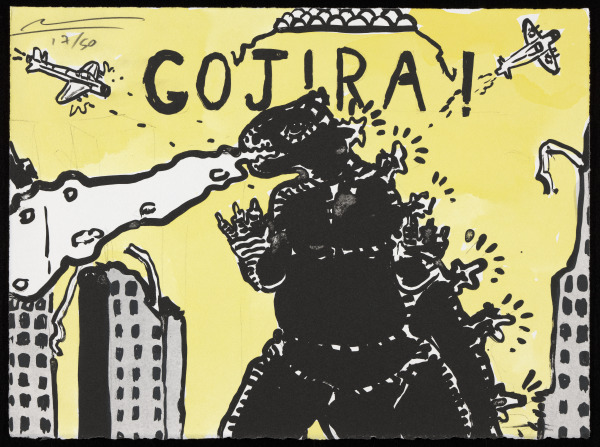 King of the Monsters, 1999, Mateo Romero (Cochiti, b. 1967), lithograph. Virginia Museum of Fine Arts, Funds provided by Margaret A. and C. Boyd Clarke and Aldine S. Hartman Endowment Fund, 2020.156
King of the Monsters, 1999, Mateo Romero (Cochiti, b. 1967), lithograph. Virginia Museum of Fine Arts, Funds provided by Margaret A. and C. Boyd Clarke and Aldine S. Hartman Endowment Fund, 2020.156 Mateo Romero of Cochiti Pueblo is Diego Romero’s brother. Known predominantly for his paintings, Mateo has also worked in the medium of printmaking on occasion. This print, titled King of the Monsters, and one other of Romero’s, titled “Gods of the Warm, Cold, Middle,” were created as part of the special project Trickster at the Tamarind Institute in 1999. Four San artists from the Kalahari Desert in Africa and four artists from various Pueblos in New Mexico were invited to participate in the project. Each was asked to share stories from their own cultures about the trickster character. The results were inventive interpretations, ranging in topics of transformation to storytelling and to traditional methods of communication.
Explore all of the prints included in this project on the Tamarind Institute website.
Learn more about the Tamarind Institute.
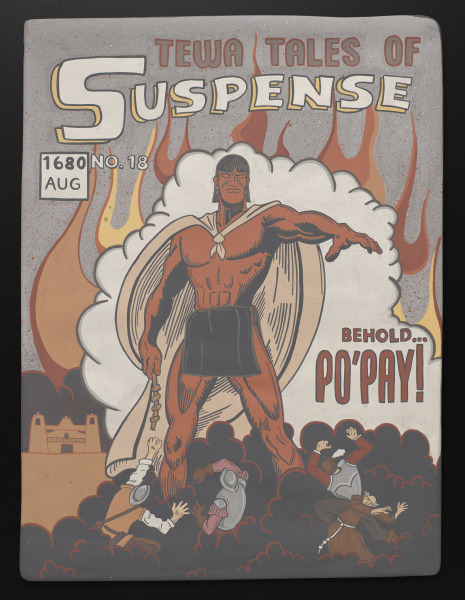 Tewa Tales of Suspense #18: Behold PO’PAY!, 2011, Jason Garcia (Santa Clara, b. 1973), ceramic and pigment. On loan from the Edward J. Guarino Collection, L2022.6.2
Tewa Tales of Suspense #18: Behold PO’PAY!, 2011, Jason Garcia (Santa Clara, b. 1973), ceramic and pigment. On loan from the Edward J. Guarino Collection, L2022.6.2 Jason Garcia is a Santa Clara Pueblo artist who comes from a long line of traditional and contemporary Pueblo potters, including his parents, aunts and grandmothers. Early in his career he began experimenting with creating ceramic tiles rather than the more traditional vessel forms. He uses the tile format to document cultural traditions of the Santa Clara Pueblo, focusing on daily life scenes, dances, religious icons and the like. But in his “Tewa Tales of Suspense” series, he has revived the Marvel Comic series “Tales of Suspense” from the 1950s-60s, utilizing iconic imagery from that series to represent Pueblo heroes, such as Po’Pay, the leader of the Pueblo Revolt of 1680.
Learn more about Po’Pay: The Little-Known Pueblo Hero Who Led the First American Revolution.
Steu and Cuda are from Virgil Ortiz’s series Pueblo Revolt 1680/2180, a collection of ceramic figures that illustrate a storyline Ortiz created to tell the history of the Pueblo Revolt by connecting it to a sci-fi, futuristic narrative. 19th century Cochiti potters created ceramic figures for similar purposes of social commentary.
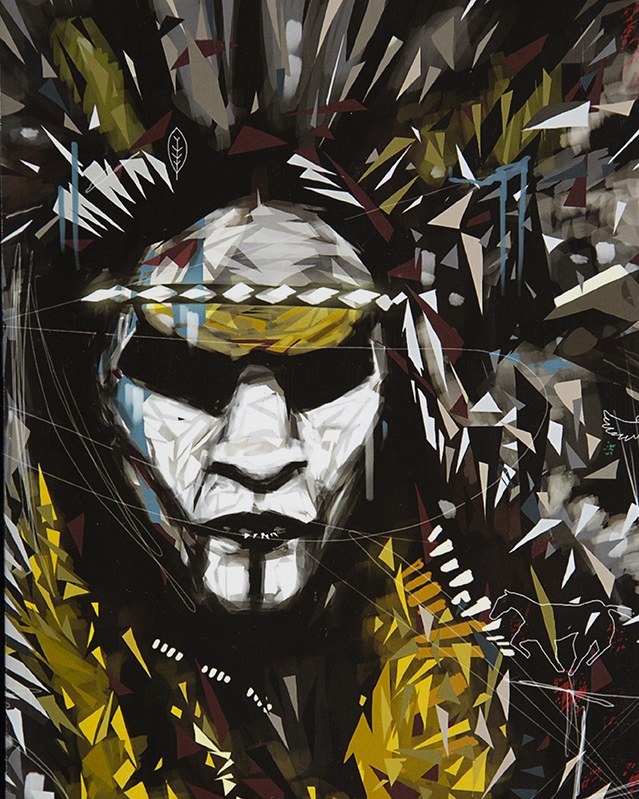 Moonshot, 2021, vol. 1, Stephen Gladue (Métis, birthdate unknown) Inhabit Education Books, Inc. Virginia Museum of Fine Arts, Margaret R. and Robert M. Freeman Library and Special Collections
Moonshot, 2021, vol. 1, Stephen Gladue (Métis, birthdate unknown) Inhabit Education Books, Inc. Virginia Museum of Fine Arts, Margaret R. and Robert M. Freeman Library and Special Collections The cover image for Moonshot: The Indigenous Comics Collection, Volume 1 is titled “Northern Crow” and was painted by Metis artist Stephen Gladue. The image was inspired by traditional Plains dancers and honors the crow as a bringer of messages. Volumes two and three also feature Gladue’s work on the cover. This three-volume anthology includes beautifully illustrated stories from Indigenous writers and visual artists along with select sketchbook excerpts and biographies. The mission of the series is a call to action for Indigenous stories to be told by Indigenous people.
This volume includes the story UE-Pucase: Water Master written by Arigon Starr and illustrated by David Cutler. In this adventure set in the far-distant future, she has adapted a Muscogee Creek story about a young man who turns into a snake after eating forbidden foods.
Learn more about Moonshot: The Indigenous Comics Collection.
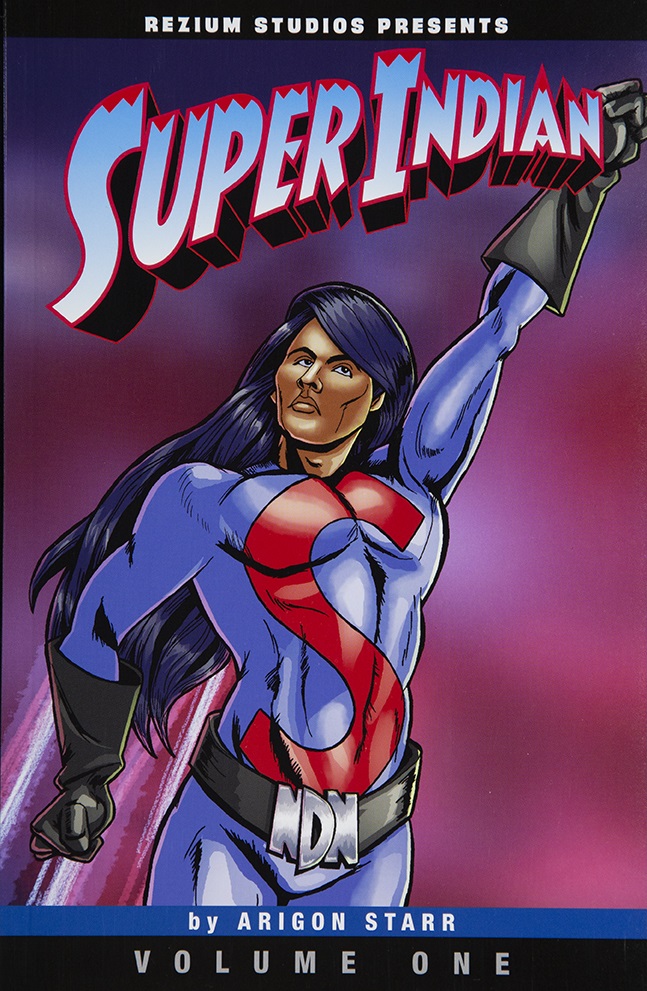 Super Indian, 2012, vol. 1, Arigon Starr (Kickapoo, b. 1972), Wacky Productions Unlimited. Virginia Museum of Fine Arts, Margaret R. and Robert M. Freeman Library and Special Collections
Super Indian, 2012, vol. 1, Arigon Starr (Kickapoo, b. 1972), Wacky Productions Unlimited. Virginia Museum of Fine Arts, Margaret R. and Robert M. Freeman Library and Special Collections Arigon Starr’s “Super Indian” made his first appearance in a ten-minute radio show. It was such a hit that 10 more episodes followed in which the hero’s origin story was revealed! Hubert Logan, an ordinary boy from Leaning Oak Reservation ate commodity cheese that was laced with “Rezium,” a secret government food additive—and Super Indian, Hubert’s alter ego was born!
Starr and Wacky Productions Unlimited’s Janet Miner soon founded a new company called Rezium Studios to create new Super Indian adventures in multiple mediums. The first printed Super Indian comic book was issued in April 2012.